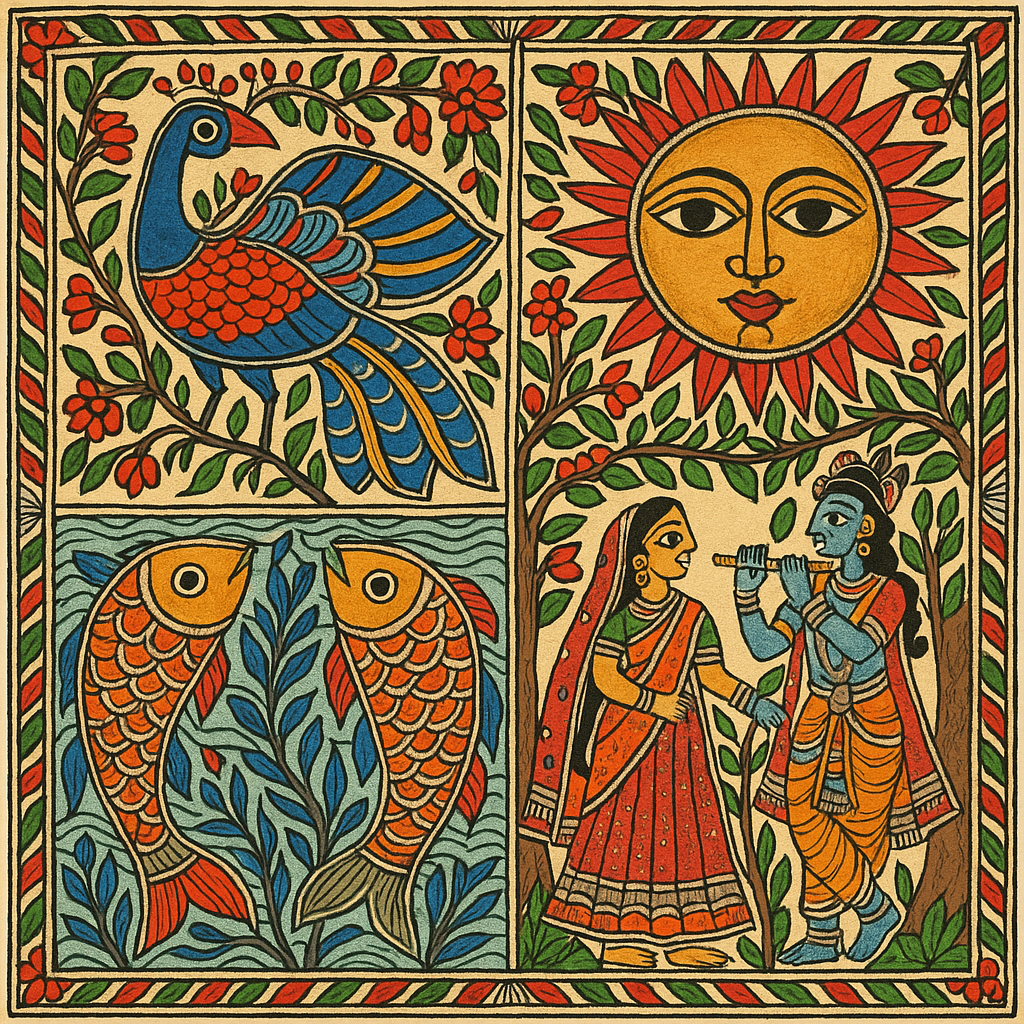The Madhubani designs painting, also referred to as Mithila paintings, is a revered piece of India’s rich cultural heritage. Originating from Bihar, this art form is well-known for its slender outline, intricate detail and vibrant colours. Traditionally, the paintings were painted on walls. Madhubani designs have been extended into murals, fabrics and even home decor, serving as a lively representation of India’s diversity.
The Madhubani paintings style is one of the most renowned and oldest art forms in India. Its distinctive style is comprised of geometric designs, double lines, and bright natural colours. Traditional Madhubani painting designs were traditionally drawn on the walls of mud at weddings and festivals. In recent times, they’ve been adapted to a variety of mediums, such as fabrics, paper and even digital art.
The Madhubani painting typically conveys an emotional story, regardless of its subject matter, which may include nature, gods, or human emotions. Modern interior designers appreciate these designs since they add authenticity as well as culture and colour to the homes they decorate. For those who appreciate art, searching for “Madhubani painting design” offers inspiration to connect tradition with contemporary aesthetics.
Madhubani Art Design
The appeal of the Madhubani art style lies in its deep cultural roots. Each design, brimming with symbols such as peacocks for wealth, fish for beauty, and the lotus symbolising purity, carries significant cultural and spiritual meanings.
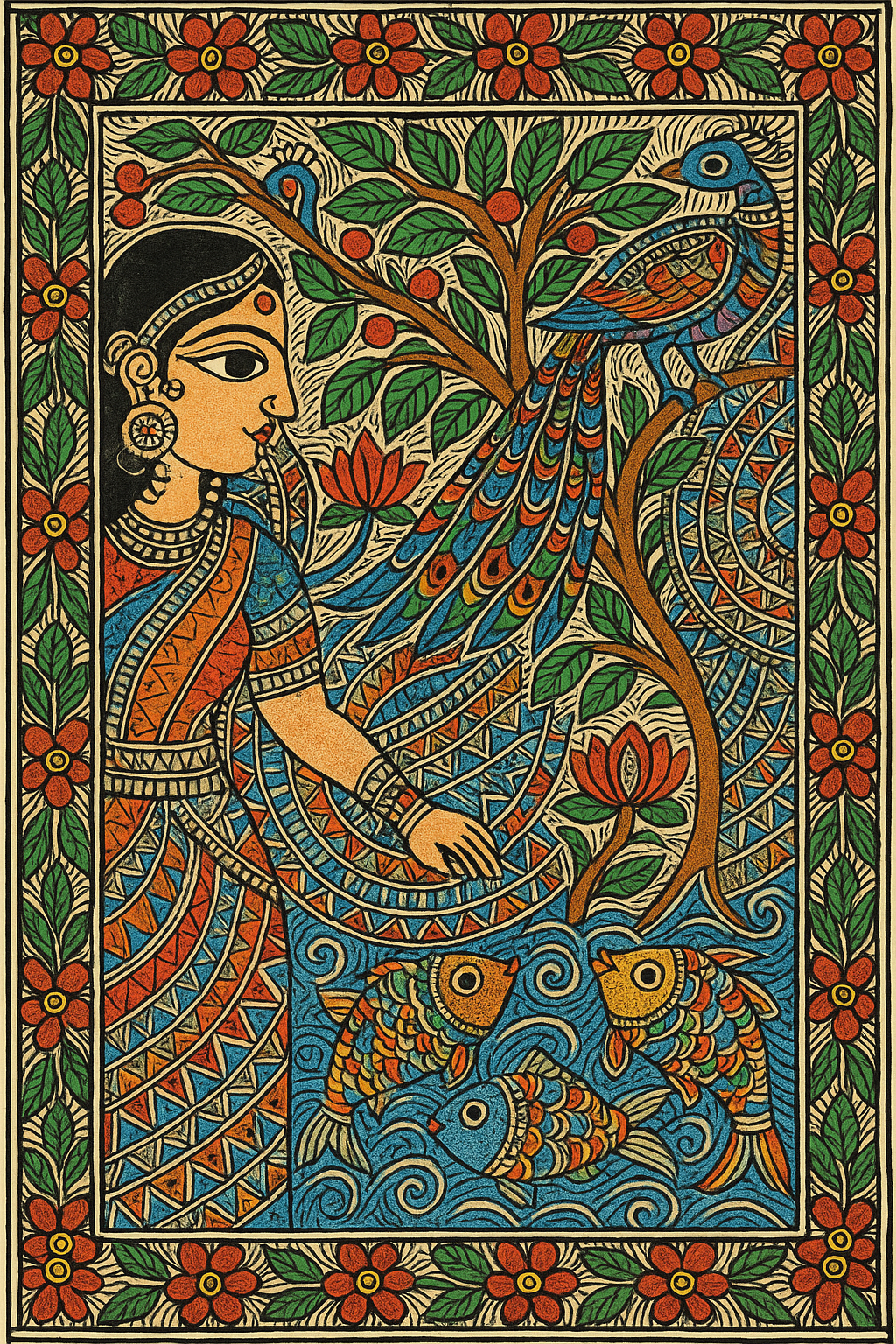 Madhubani Art Design
Madhubani Art Design
In contrast to the generic prints and designs of today, Madhubani designs are a tribute to India’s rich cultural heritage, fostering a sense of connection and appreciation among art enthusiasts.
Mithila Painting Design
Mithila paintings, also known as Madhubani art, have garnered international recognition for their authenticity and symbolic narratives. Originating from the Mithila region in Bihar, these paintings reflect the traditions, rituals, and stories of the community. Whether used for festivals or displayed as art, each Mithila painting is a part of the living history, contributing to the rich legacy of Indian art and appealing to a global audience.
Indian Folk Art Design
India is home to a variety of folklores; however, Madhubani is among the most well-known. A classic Indian folk art style, the Madhubani style, has strong lines, a series of borders, and a filled-in background. These designs were painted on walls for festivals such as Holi, Diwali, or weddings.
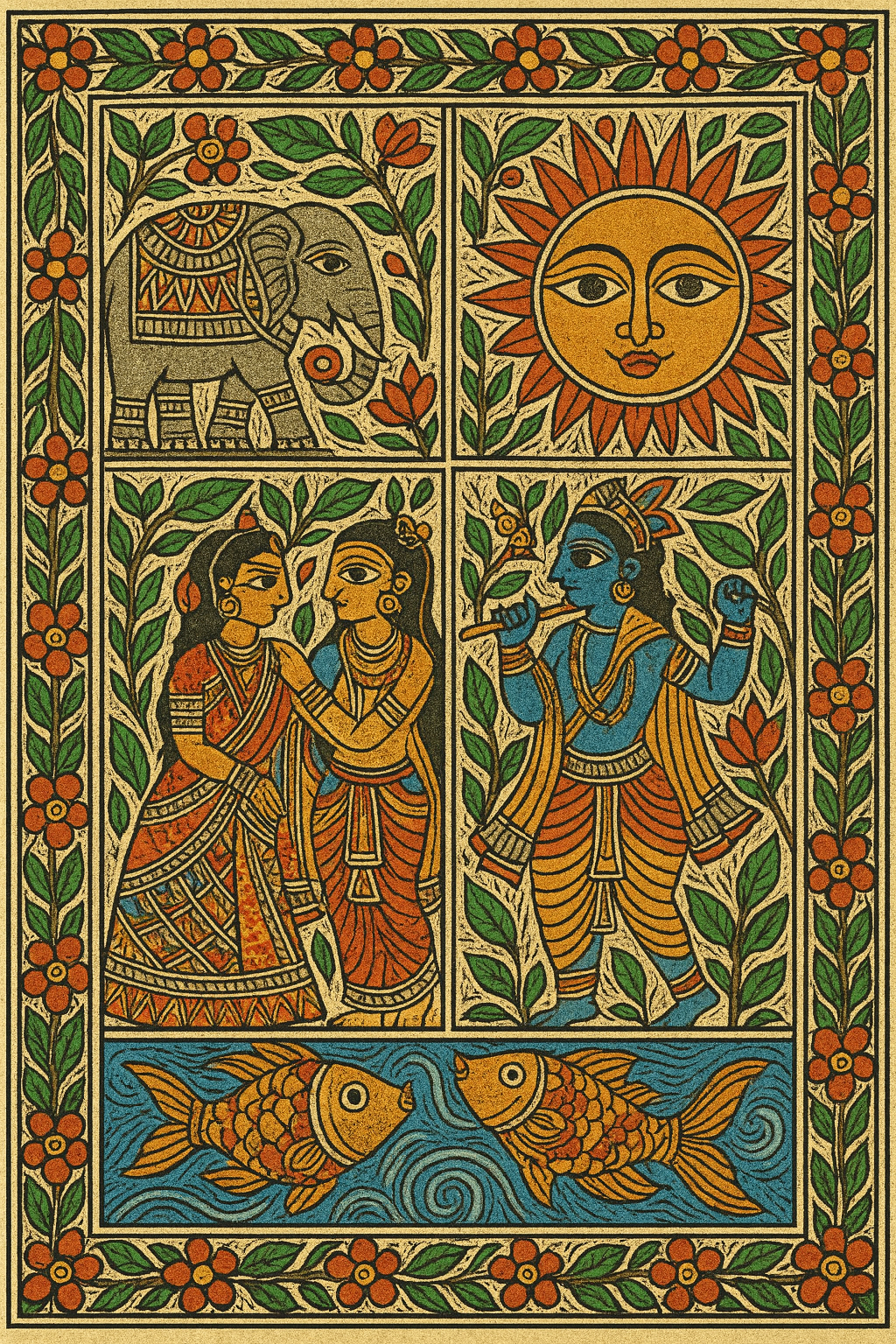
Today, Indian folk art design is widely praised worldwide as a reflection of India’s creativity. From borders on sarees to massive murals, its versatility makes it in fashion. The acclaim for “Indian folk art design” illustrates how people all over the globe are embracing Madhubani as a part of authentic tradition and culture.
Traditional Madhubani Design
Traditional Madhubani design is drawn by hand and is meticulously intricate, with no area left unmarked for drawing. Artists typically depict gods, mythological tales, and nature in vivid colours. The traditional way of doing this is to use natural colours, which ensures eco-friendliness.
Traditional Madhubani design is not merely a decorative art form, but also a narrative tradition that has been passed down through generations. While modern-day adaptations are available, people still prefer the traditional Madhubani design due to its authenticity and cultural significance. It can be placed in museums, homes, or religious places, and it will continue to protect the rich heritage of Indian tradition.
Madhubani Peacock Design
The Madhubani peacock design is among the most sought-after designs within this form of art. Peacocks symbolise beauty, grace and abundance. When painting with Madhubani, artists typically draw attention to the bird’s feathers by creating intricate patterns and vibrant colours.

These designs are very popular in the forms of sarees, murals, and rangoli. The Madhubani Peacock pattern instantly adds elegance to any space. Interior designers typically suggest the design for walls in living rooms or entranceways. The combination of symbolism from the past and aesthetic attractiveness makes it among the most sought-after and desired patterns.
Madhubani Fish Design
The Madhubani fish symbolises prosperity, fertility and luck. In traditional Madhubani art, fish are often depicted in groups or pairs, surrounded by geometric borders. A Madhubani fish motif is typically used in wall painting designs, rangoli patterns, and textile prints.
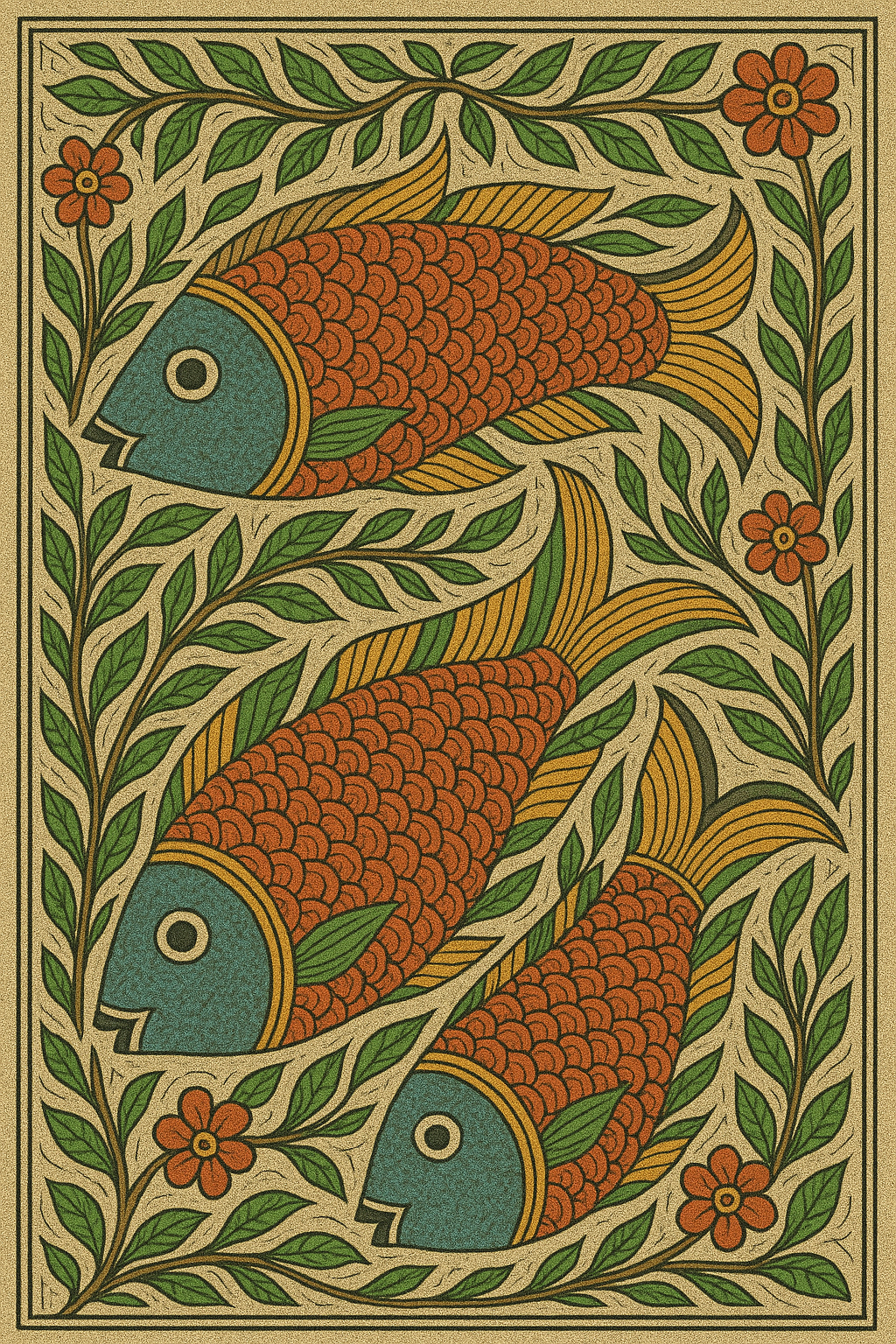
It is believed to be auspicious, which makes it a favourite for weddings and ceremonies. Nowadays, designers can also incorporate the motif of the fish into modern interior decor and fashion accessories. People searching the internet for “Madhubani fish design” often seek artwork that combines beauty and cultural significance.
Madhubani Lotus Design
A Madhubani lotus is a symbol of purity, divinity, and peace. In Indian tradition, the lotus is often associated with goddesses and gods, which makes it a symbol of sacredness. Artists employ bright colours of pink, red and blue to make the lotus come to life.

The Madhubani lotus pattern is usually painted in meditation rooms, prayer areas, or in colourful rangolis. It is also featured in saree prints and murals. Many people appreciate designs based on the lotus due to its soothing impact, as well as its connection to spirituality. The acclaim for the “Madhubani lotus design” continues to grow in both contemporary and traditional art spaces.
Madhubani Sun Design
The Madhubani sun design is a striking and distinctive design element in this form of art. The sun symbolises life, energy and wealth. Artists typically draw it with bright lines and glowing circles, encasing it with intricate designs. In the past, Madhubani sun designs were created during rituals to honour the natural world.
These days, they are used as wall decor or murals, and are also available as digital prints. A Madhubani sun design can bring light and positivity to any room, making it a perfect choice for offices or living spaces. The term remains highly sought after by individuals seeking artwork that holds meaning for them.
Radha Krishna Madhubani Design
The Radha Krishna Madhubani design reflects the love of God and his devotion. Artists portray the timeless connection of Radha and Krishna by using vibrant designs, floral borders and intricate backgrounds. These paintings are commonly used for wedding decorations, in sacred areas, and as home decorations.
The Radha Krishna Madhubani painting symbolises harmony, love, and spirituality, making it a favourite among art enthusiasts. People who search for this term usually seek out artwork that combines the beauty of culture with spirituality. It is one of the most recognisable themes in Madhubani painting.
Madhubani Tree of Life Design
The Madhubani Tree of Life design represents the growth of connection, development, and strength. Artists typically create large trees that have branches and leaves stuffed with birds, animals and even flowers. The motif symbolises the harmony between nature and humans.
Nowadays, the Madhubani Tree of Life design is often utilised for murals, wall art, and even fashion fabrics. Its religious significance makes it a favourite for meditation rooms and green interior decor. The term “Madhubani tree of life design” remains relevant in a time when people are seeking environmentally sustainable, meaningful, and naturally inspired art.
Madhubani Elephant Design
The Madhubani elephant symbolises power, wisdom and wealth. Artists usually depict elephants using designs that are often decorated with deities or floral patterns. The Madhubani elephant motif is often seen in saree borders, murals and rangoli. The design is frequently employed in weddings and other festive decorations because it signifies happiness and prosperity.
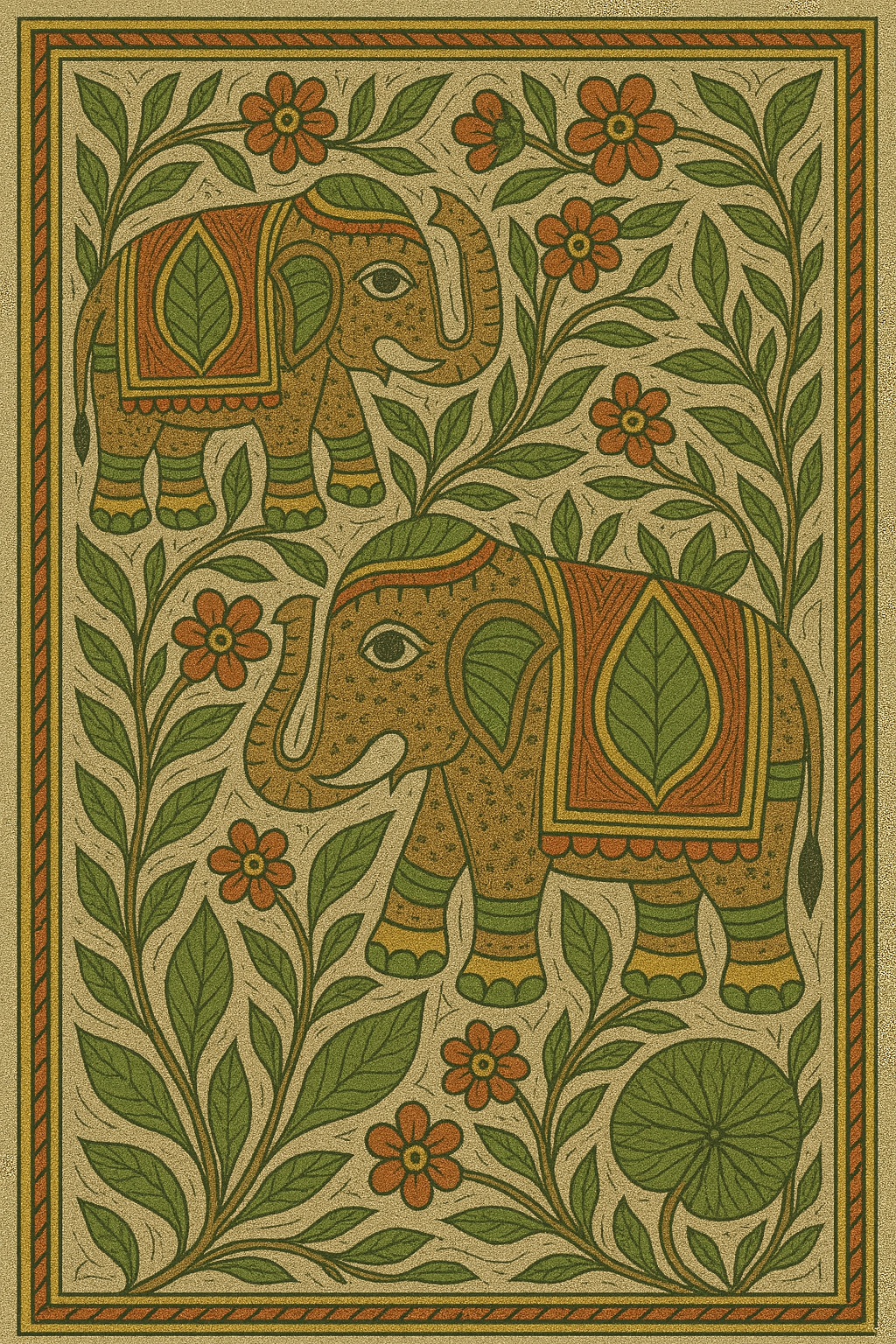
Nowadays, designers incorporate elephant-themed designs into various home decor items, including curtains, cushions, and wall panels. Google searches of “Madhubani elephant design” highlight its appeal as an old-fashioned and modern design feature.
Handpainted Madhubani Design
The handpainted Madhubani design is authentic and reflects the creator’s creativity and personal flair. In contrast to printed copies, every handpainted design is distinctive and demonstrates the artist’s talent. The designs are typically created on handpainted canvas, paper, or other fabrics. The handpainted Madhubani design may include themes such as peacocks or fish, as well as Radha or Krishna.
Art enthusiasts and collectors appreciate the originals for their authenticity. Nowadays, handpainted designs are also popular as gifts that represent craftsmanship and culture. The phrase “handpainted Madhubani design” attracts customers who seek the originality and authenticity of this style.
Geometric Madhubani Design
The geometric Madhubani design emphasises the use of squares, triangles, circles, and lines to create balance. Artists often blend geometries with organic themes, such as birds, flowers, and animals. These designs are intricate and visually appealing. The geometric Madhubani design is frequently used as a border, as well as fabric prints and even modern wall art.
Designers adore these patterns since they combine traditional with contemporary design. The results of searches for “geometric Madhubani design” show the increasing demand for organised, attractive art that is visually appealing.
Line Art Madhubani Design
The Madhubani line art is among the most minimal yet powerful styles of this form of art. Artists often employ delicate lines, typically using black and white to create intricate designs. Contrary to vibrant design lines, Madhubani designs focus on symmetry and precision.
They are often employed in sketchbooks, pencil drawings, and modern digital versions. Line art designs from Madhubani are renowned for their use in illustrations, tattoos, and contemporary interiors. The phrase “line art Madhubani design” will appeal to those who appreciate simplicity and a sense of cultural depth.
Intricate Madhubani Painting Design
A detailed Madhubani painting is brimming with detail and leaves no room for error. Artists utilise precise strokes and repeated patterns to add depth and beauty to their work. These designs typically take weeks or even days to complete, which is why they are extremely valuable.
A complex Madhubani painting may include mythological tales intertwined with floral motifs and cosmic symbolism. Nowadays, they are sought after in high-end interiors and exhibitions. People who search for this term usually seek out works that are luxurious, precise, accurate, and authentic.
Colourful Madhubani Design
The vivid Madhubani design is the reason this art form is popular worldwide. In the past, natural dyes extracted from leaves, flowers or minerals could be used to produce vivid colours, such as vibrant greens, reds, yellows and blues. Nowadays, artists are also using modern paints, but they retain the lively look.
A vibrant Madhubani design is perfect for decorating homes as well as festivals and fabric prints. The vibrant appearance of the design is a favourite for living and social spaces. Google searches for “colorful Madhubani design” reveal the widespread appreciation for its vibrant colours and festive appeal.
Traditional Folk Design of Madhubani
Traditional Madhubani folk designs depict the rural lifestyle, mythology, and religious rituals of the region. The designs are hand-painted and often created by women from villages for special celebrations. They feature motifs of gods as well as animals, fish, and the sun.
Traditional Madhubani folk art is appreciated for its authenticity, as it remains true to the roots of the art. Nowadays, these designs are incorporated into cultural exhibits, handicraft fairs, and temple decorations. The theme continues to draw people who seek a genuine connection to the Indian folklore.
Madhubani Wall Design
A Madhubani wall style is a popular choice for interior decorators. They can transform plain walls into lively canvases for storytelling. Traditionally, they were painted on mud walls. The modern Madhubani wall designs are often seen in hotels, living rooms and cultural centres.
The most popular designs include peacocks, gods, and trees, typically painted in vibrant colours. A Madhubani wallpaper instantly brings a touch of class to an area. People who search for this term generally seek ideas for interior decor that blends beauty and tradition.
Madhubani Home Decor Design
The Madhubani design style for home decor is gaining popularity. From cushions to lampshades, Artists incorporate Madhubani designs into everyday items. The Madhubani interior design typically features peacocks, fish, or floral patterns within its borders. These designs bring colour and a sense of culture into contemporary homes.
Today, interior designers recommend Madhubani home decor designs to create unique, ethnic-inspired spaces. This is a sign of the growing demand for traditional art in modern lifestyle products.
Madhubani Mural Design
The Madhubani mural is an excellent design for large walls and public areas. They often depict mythological tales or gods, as well as natural scenes. A Madhubani-inspired mural is vibrant and detailed, making it perfect for temples, hotels, or even cultural centres. Nowadays, many urban homes also feature Madhubani-inspired murals, adding an artistic touch. This is a popular choice for those seeking large-scale, influential art that is rooted in tradition.
Madhubani Border Design
Madhubani Border design can be described as a pattern of decorative value used to cover paintings, fabrics, and sarees. Borders typically feature geometric designs, flowers, and animal-themed motifs. They provide stability and balance to the work. They provide balance and structure to the artwork.
Madhubani border is often employed in fashion, textiles and even in architectural designs. Designers like it for the edges of sarees as well as dupattas and interior decor. The term is still popular with people who seek out patterns from the past that are attractive.
Madhubani Fabric Design
The Madhubani style of fabric has been incorporated into contemporary fashion. Kurtas, sarees, and dupattas, as well as modern dresses, are now featuring Madhubani designs. The Madhubani fabric design often features peacocks, lotus blossoms, or fish painted with vivid colours.
These fabrics are popular for both contemporary and traditional wardrobes. Designers adore Madhubani fabric because it effortlessly blends cultural richness with a stylish, easy-to-wear aesthetic. The keyword appeals to buyers seeking ethnic and fashionable clothing.
Madhubani Rangoli Design
The Madhubani pattern is typically created on floors during festivals such as Diwali, Holi, and weddings. The designs are based on lotus, fish, or sun-inspired motifs and are adorned with vibrant colours, along with geometric lines. A Madhubani design is believed to be a symbol of luck, as it can bring positive energy and prosperity to homes. Currently, many people create digital rangolis using patterns inspired by the Madhubani style.
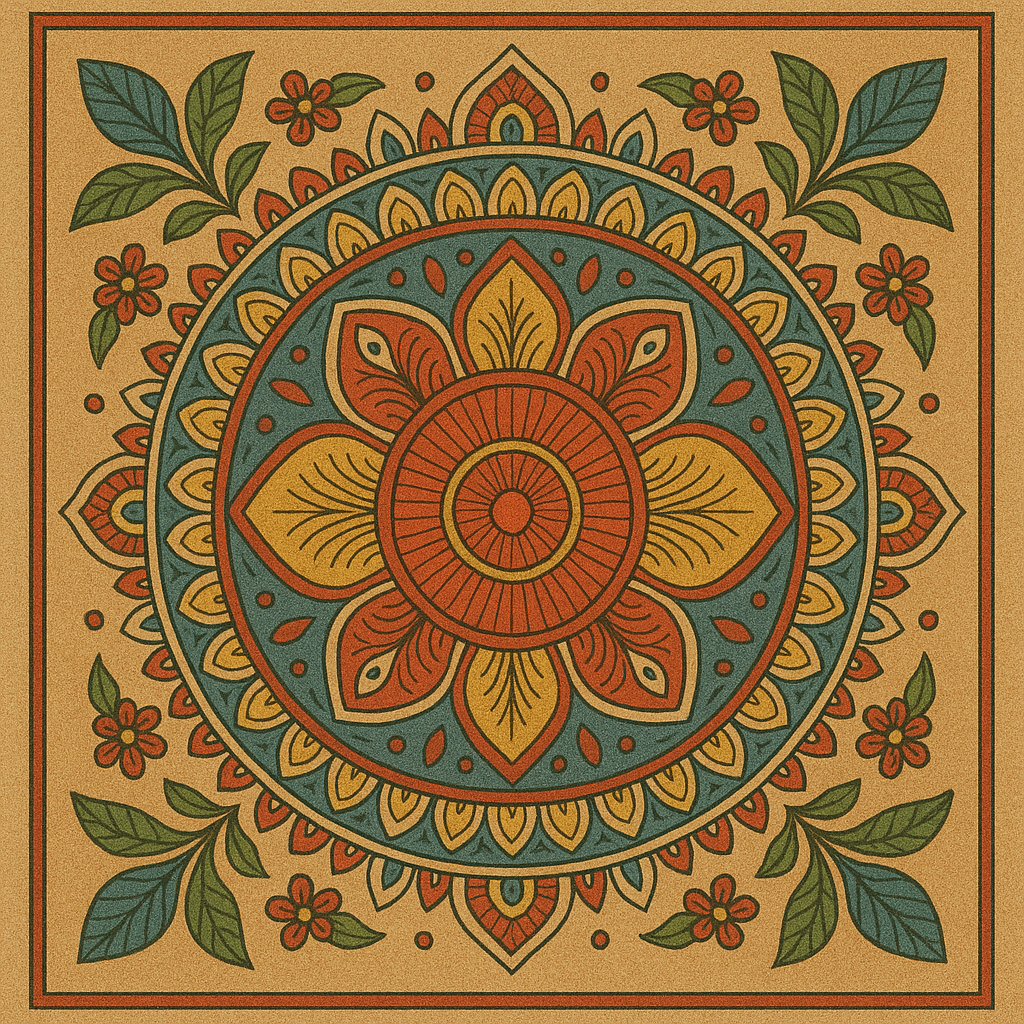
The term “Madhubani rangoli design” remains popular during the festive season, underscoring its cultural significance and enduring appeal.
Latest Madhubani Painting Designs
People seeking the most recent Madhubani painting styles are typically looking for modern interpretations of the traditional style. Artists are currently experimenting with fresh designs, fusion colours, and contemporary designs.
These new Madhubani designs are in high demand for fashion exhibitions, interior design projects, and international exhibitions. They blend tradition with modernity, making them suitable for the younger generation. The word “keyword” reflects the constant development in Madhubani art.
Modern Madhubani Design Ideas
The current Madhubani design trend is focused on mixing. Artists often combine traditional themes with abstract minimalist design, utilising digital printing methods to create distinctive and original pieces. These designs are ideal for workplaces and homes in urban areas.
Modern Madhubani designs could feature lines of peacocks, digital lotus patterns, and abstract tree-of-life murals. This is the kind of design that attracts people who want traditional art but with a contemporary new twist.
Unique Madhubani Artwork Designs
The distinctive Madhubani artwork category features rare and personal designs. Artists explore themes such as environmental awareness, feminism or contemporary storytelling.
The unique Madhubani artwork is unusual because it’s unique. Collectors typically look for this phrase to locate original artworks that aren’t manufactured in mass quantities. It showcases the originality and diversity that are the hallmarks of Madhubani artists.
Popular Madhubani Designs 2025
The Madhubani design, a top search term in 2025, reflects current art trends. It includes topics such as ecological consciousness, minimalist line art, and digital interpretations. People who search for this term are seeking new concepts in fashion, decor and even exhibitions. It shows how Madhubani is relevant even after 2025.
Custom Madhubani Painting Designs
The Madhubani-inspired custom design trend allows buyers to personalise their artwork. Artists create custom-made works tailored to the customer’s needs, such as specific motifs, colours, or stories.
A customised Madhubani painting is typically purchased for weddings, anniversaries, or to decorate your home. This is a sign of the growing demand for custom-designed artwork in the current marketplaces.
Authentic Madhubani Folk Designs
Original Madhubani folk designs are still the most sought-after. They are created by artisans of the past using natural colours and authentic methods. Genuine Madhubani folk designs typically portray gods, rituals, and nature with minimal modern influences. People who search for this term are seeking authentic art that will preserve India’s rich heritage.
Conclusion
Madhubani design paintings represent a treasure trove of Indian tradition, mixing tradition, imagination and symbolic meaning. From Madhubani peacock designs to Madhubani rangoli, every keyword is a distinct feature of this ancient art. If you’re looking for traditional designs, such as folk or contemporary Madhubani designs, this art form continues to inspire and bring people together.

